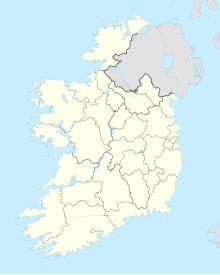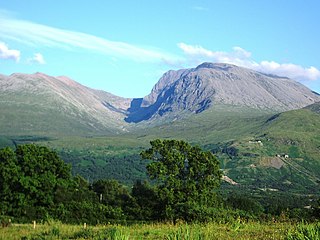
A Munro is defined as a mountain in Scotland with a height over 3,000 feet (914.4 m), and which is on the Scottish Mountaineering Club (SMC) official list of Munros; there is no explicit topographical prominence requirement. The best known Munro is Ben Nevis, the highest mountain in the British Isles at 4,411 ft.
Cessair or Cesair is a character from a medieval Irish origin myth, best known from the 11th-century chronicle text Lebor Gabála Érenn. According to the Lebor Gabála, she was the leader of the first inhabitants of Ireland, arriving before the Biblical flood. The tale may have been an attempt to Christianize an earlier pagan myth.

Ireland is an island in Northern Europe in the north Atlantic Ocean. The island, of up to around 480 km (300 mi) north-south, and 275 km (171 mi) east-west, lies near the western edge of the European continental shelf, part of the Eurasian Plate. Its main geographical features include low central plains surrounded by coastal mountains. The highest peak is Carrauntoohil, which is 1,039 metres (3,409 ft) above sea level. The western coastline is rugged, with many islands, peninsulas, headlands and bays, while the southern and northern coasts feature a smaller number of substantial sea inlets, such as Lough Foyle and Cork Harbour; no part of the land is more than around 110 km (68 mi) from the sea. It was administratively divided into 32 counties, gathered in 4 provinces, though current arrangements, especially in Northern Ireland, differ from this model. The island is almost bisected by the River Shannon, which at 360.5 km (224 mi) with a 102.1 km (63 mi) estuary is the longest river in Ireland and flows south from County Cavan in the province of Ulster to form the boundary between Connacht and Leinster, and later Munster, and meet the Atlantic just south and west of Limerick. There are a number of sizeable lakes along Ireland's rivers, of which Lough Neagh is the largest.

The Wicklow Mountains form the largest continuous upland area in Ireland. They occupy the whole centre of County Wicklow and stretch outside its borders into the counties of Dublin, Wexford and Carlow. Where the mountains extend into County Dublin, they are known locally as the Dublin Mountains. The highest peak is Lugnaquilla at 925 metres.
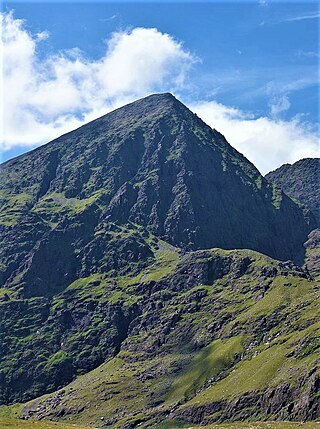
Carrauntoohil, Carrauntoohill or Carrantuohill is the highest mountain in Ireland at 1,038.6 metres. It is on the Iveragh Peninsula in County Kerry, close to the centre of Ireland's highest mountain range, MacGillycuddy's Reeks. Carrauntoohil is composed mainly of sandstone, whose glaciation produced distinctive features on the mountain such as the Eagle's Nest corrie and some deep gullies and sharp arêtes in its east and northeastern faces that are popular with rock and winter climbers.

Sutton is a residential suburb on the Northside of Dublin, Ireland. It occupies the tombolo which links Howth Head to the mainland, some of the lower slopes of Howth Hill, and a little of the adjacent coasts. The area lies within the jurisdiction of Fingal County Council. There is a small commercial core at the Sutton Cross road intersection.

The Wicklow Way is a 131-kilometre (81-mile) long-distance trail that crosses the Wicklow Mountains in Ireland. It runs from Marlay Park in the southern suburbs of Dublin through County Wicklow and ends in the village of Clonegal in County Carlow. It is designated as a National Waymarked Trail by the Irish Sports Council and is waymarked by posts with a yellow "walking man" symbol and a directional arrow. Typically completed in 5–7 days, it is one of the busiest of Ireland's National Waymarked Trails, with up to 24,000 people a year walking the most popular sections. The Way is also used regularly by a number of mountain running competitions.

Lugnaquilla is the highest of the Wicklow Mountains in Ireland, rising to 925 metres (3,035 ft). It is also the highest Irish mountain outside of County Kerry, and the highest point in County Wicklow and the province of Leinster. Lugnaquilla overlooks the Glen of Imaal to the west and Glenmalure to the east.

Fintan O'Toole is an Irish journalist, literary editor, and drama critic for The Irish Times, for which he has written since 1988. O'Toole was drama critic for the New York Daily News from 1997 to 2001 and is a regular contributor to The New York Review of Books. He is also an author, literary critic, historical writer and political commentator.
Saint Fintán, or Munnu is one of the saints of Ireland and Britain who served in Ireland and Scotland being the founder and abbot of the abbey at Teach-Mhunn - The House of Saint Munn - where his bed may be visited is a pilgrimage site; today Taghmon is in the County Wexford, in the province of Leinster Ireland. In Scotland, he is venerated as the patron saint of Clan Campbell.

Taghmon is a village in County Wexford, Ireland. It lies on the R738 regional road, 14 km west of Wexford town and 25 km east-southeast of New Ross.
Philip Gray was an Irish republican, revolutionary and a member of the Irish Confederation. He took part in the Risings of 1848 and 1849 along with James Fintan Lalor and both James Stephens and John O'Mahony, who would go on to establish the Irish Republican Brotherhood in Ireland and the Fenian Brotherhood in the United States.
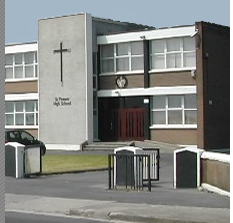
St. Fintans High School is an all-boys Roman Catholic voluntary-aided secondary school located between Sutton and Baldoyle, Dublin, Ireland.
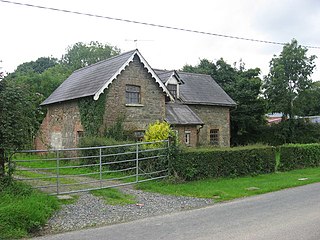
Drumcar is a village and a historical parish, in the barony of Ardee in County Louth, Ireland.
Darragh Fives is an Irish hurler who plays for Waterford Junior Championship club Tourin–Ballinwillin and at inter-county level with the Waterford senior hurling team. He usually lines out as a left wing-back.

The Arra Mountains or Arra Hills are situated in County Tipperary in Ireland, between the towns of Nenagh and Ballina, south east of Lough Derg (Shannon) and north of the M7 Motorway.
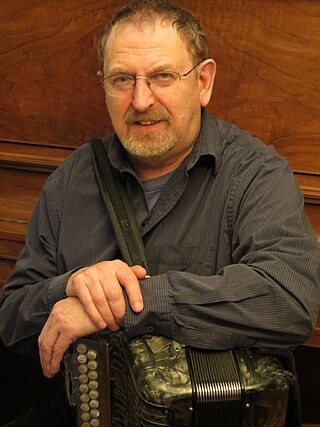
Paddy O'Brien is an Irish accordion player and memoirist, author of The Road from Castlebarnagh: Growing Up In Irish Music and creator of the Paddy O'Brien Tune Collection: A Personal Treasury of Irish Traditional Music, the first published oral collection of Irish traditional music.

Fintan Monahan KC*HS is an Irish Roman Catholic prelate who has served as Bishop of Killaloe since 2016.
A History of Ireland in 100 Objects was a joint project by The Irish Times, the National Museum of Ireland, and the Royal Irish Academy to define one hundred archaeological or cultural objects that are important in the history of Ireland. The objects are single man-made artefacts or documents, excluding buildings, ranging in date from about 5,000 BC (Mesolithic) to the early 21st century. Most of the objects are held in accessible collections in the Republic of Ireland or Northern Ireland.
